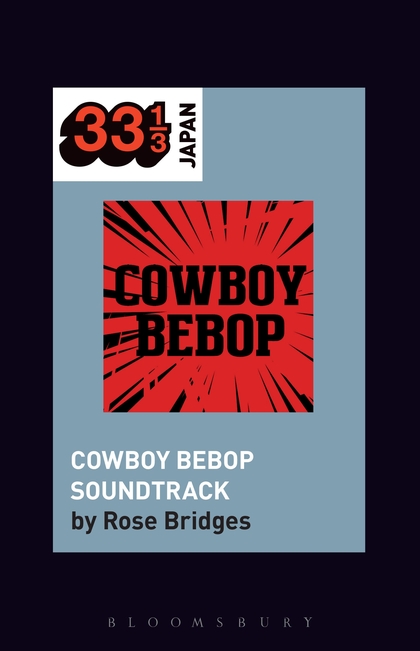Books: Yoko Kanno
January 15, 2018 · 0 comments
By Jonathan Clements.
 “I think it’s time we blow this scene. Get everybody and the stuff together. Okay: 3-2-1, let’s jam.” Admit it, you’re already hearing those brass notes as the theme song kicks in. As Rose Bridges argues in her lively, smart and revealing book Yoko Kanno’s Cowboy Bebop Soundtrack, it’s the music that lingers in the memory. One of a new series of academic texts on iconic recordings from Japan, Bridges’ book sets a high bar for writing about anime music, rich in quotations from the composer and her many collaborators.
“I think it’s time we blow this scene. Get everybody and the stuff together. Okay: 3-2-1, let’s jam.” Admit it, you’re already hearing those brass notes as the theme song kicks in. As Rose Bridges argues in her lively, smart and revealing book Yoko Kanno’s Cowboy Bebop Soundtrack, it’s the music that lingers in the memory. One of a new series of academic texts on iconic recordings from Japan, Bridges’ book sets a high bar for writing about anime music, rich in quotations from the composer and her many collaborators.
Bridges grabs her readers from the opening pages, where she drops them straight into an interview in which Kanno reveals that the anime’s unforgettable opener ‘Tank!’ was originally intended as background filler. “I only recorded about two takes of it,” Kanno confesses, “so the mistakes and flaws are still in the track. But that vigorousness was in the spirit of brass bands, and I thought that was good.”
Bridges parses Cowboy Bebop’s musical production as a jazzy improvisation, undertaken long before many elements of the anime series were manifest – several interviewees admit that they knew nothing about it beyond Kanno’s musical directions. She talks to director Shinichiro Watanabe, whose love of Sam Peckinpah’s Pat Garrett and Billy the Kid would lead to the lifting of the title of its most memorable Bob Dylan track for the Bebop movie, Knockin’ on Heaven’s Door, and whose adoration of Dirty Harry brought him into contact with the style of Lalo Schifrin.
 Kanno’s discography is so sprawling and complex that it would take a far bigger book to unravel it in its entirety. Bridges focuses on a handful of key Kanno works that help tell the story of her artistic development, including Macross Plus, for which she had to ghost-write the galaxy-wide pop hits of Sharon Apple, and the post-Bebop devotional influences of her score for Wolf’s Rain. There is also a noble attempt to site Cowboy Bebop within Shinichiro Watanabe’s other works as director, and discussion with Kanno’s many collaborators about her “style” – or perhaps, the total lack of a single style that allows her to seize influences from a grab-bag of genres.
Kanno’s discography is so sprawling and complex that it would take a far bigger book to unravel it in its entirety. Bridges focuses on a handful of key Kanno works that help tell the story of her artistic development, including Macross Plus, for which she had to ghost-write the galaxy-wide pop hits of Sharon Apple, and the post-Bebop devotional influences of her score for Wolf’s Rain. There is also a noble attempt to site Cowboy Bebop within Shinichiro Watanabe’s other works as director, and discussion with Kanno’s many collaborators about her “style” – or perhaps, the total lack of a single style that allows her to seize influences from a grab-bag of genres.
Bridges argues that Kanno’s work has shown a constant ability to create a unifying theme to the music she supplies to particular shows, even if they include polyphonic chants in Zentraedi, bagpipes, bongos and a song whose lyrics entirely comprise the recitation of pi to two dozen decimal places. But it’s Cowboy Bebop that gets all the love, with stories of recording sessions and compositional inspiration that left this reader desperate to fire up the iPod as soon as possible for another listen. Steve Conte, who sang the lyrics on ‘Call Me, Call Me’, recalls the tension of being forced by Kanno to sing live with a full orchestra. “I guess she wanted that feeling, and I’m glad she did it this way, because it was like the experience of a lifetime. I never recorded live with strings! Only Frank Sinatra does that.”
Within Bebop itself, Bridges singles out certain episodes for particular comment, not so much for their music but for the easter-egg references to other music. She observes, as only a musicologist can, that Bebop’s references often reflect the blues as filtered through rock music, rather than the original versions of the songs. She perceives the show’s very title, a juxtaposition of noun and musical genre much since imitated in lesser serials, to be evocative of a similar liminal moment in the history of jazz, when the arrival of bebop transformed the kind of venues where it was heard, just as Cowboy Bebop represented a segue from the serious portents of Neon Genesis Evangelion, to pulpier, more exuberant sci-fi. Subsequent chapters use the show’s music as echoes of its onscreen references – to Westerns, to Blaxploitation, and sundry other genres – as well as themes illustrative of particular characters.
Bridges’ work grows out of a desire to understand the work that Kanno specifically undertakes on one particular show. As a result, it stops short of dealing more generally with Kanno’s working methods – her fetishes for weird instruments on other anime titles, her mastery of orchestration, or her undeniable skill at imitation to order, which some internet pundits have mistaken for plagiarism. Whispers inside the anime industry treat Kanno as something of an untouchable celebrity – I know of at least one producer who refused to hire her because, although he knew she was the best, he couldn’t afford it. It would have been nice to have heard a little more about such technical issues – her approach to her work, her contacts in the music industry and the way she apparently avoids creative burn-out – but these are all beyond the modest scope of this joyful little book.
Jonathan Clements is the author of Anime: A History.
Leave a Reply